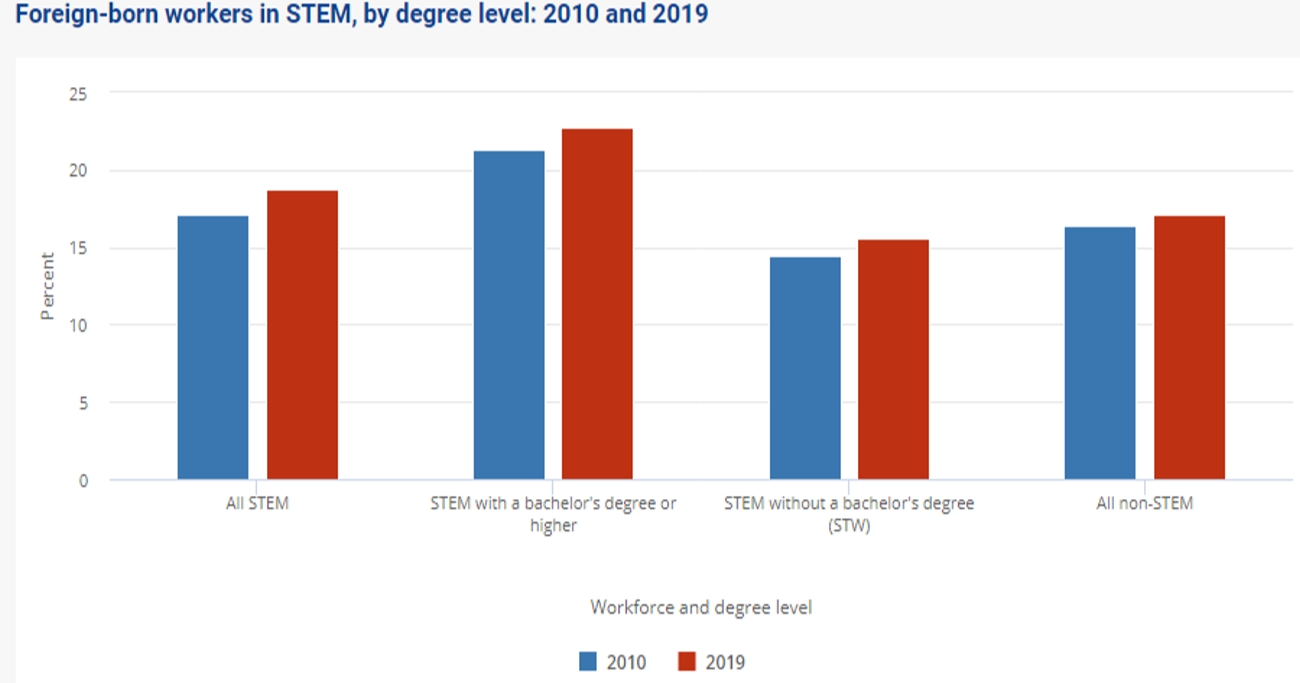Passport Obsolescence? Canada’s New Approach to Recruiting Tech Workers
Over the last five years, Canada has undergone ‘upgrades’. It has innovated and engineered new ideas to help enhance its success at combating constantly evolving obstacles such as the coronavirus, extensive climate change, and ever changing AI databases. This adaptation has been driven by talented technicians, and we are now seeing demand for these workers drastically increase. In Canada, technology talent employment grew by 15.7% from 2020 to 2022 while the United States grew by 11.4%.. These high employment rates are setting the stage for a competitive race between powerful nations who are hurrying to gather and recruit the best pool of tech workers from across the globe with the goal of pushing forward to new heights of ingenuity.
According to renowned technology entrepreneur and academic Vivek Wadhwa, “Recruiting talent is no different than any other challenge […] It is all about selling.” As such, this article will dissect state-of-the-art innovations Canada is fueling and the strategy the country is accordingly creating, with the key question remaining – what impacts will these changes have Canada, as it begins to sell itself as the ideal destination for technological development?
Canada’s Strategic Positioning for Tech
On June 27th, 2023, Immigration Minister Sean Fraser announced that Canada would be releasing its new Tech Talent Strategy – the first step towards marketing itself as a nation of superior competitive advantage when it comes to talent acquisition in the technology sector. The policy seeks to develop a new tech stream, attract digital nomads, create a new work permit for H-1B specialty visa holders, and update existing technology programs that could be outdated. Each pillar of the overarching strategy is aimed towards a different ambition which will bolster Canada’s image as an amicable destination for foreign tech workers. These ambitions include that the new tech stream and digital nomad recruitment will help create additional jobs meanwhile updating tech programs and visa permits will facilitate a smooth transition to Canada for intrigued tech workers.
Figure 1: U.S. foreign-born workers in STEM (Source: National Science Board)
A glance into the past of Canadian competitors speaks to how essential a strong tech recruitment strategy is for the country. The U.S. has long been recognized as a haven for global immigration and because of their enormous foreign population of 44.8 million, in 2019, 23.1% of the stem workforce was comprised of immigrants. Figure 1 shows the total foreign-born stem worker percentages in the U.S. as of 2019.
Canada’s new strategy is the first step to reversing what is known as the historic U.S. brain drain, dating back to the 90’s. Cheaper high-quality education drew talented workers to Canada, but post-graduation, these individuals were propelled to move to the United States for higher wages and increased job opportunities. Fortunately, improvements from past losses of immigrant workers are already on the horizon, demonstrated by Canada only having a net loss of only 3,339 employees to the United States in 2021 (a record low). Furthermore, studies showed that only 15% of Canadians believed they would be better off economically in the U.S. Continuing with successful competition and recruitment in the tech sector will require the effective implementation and use of Canada’s strategy. With that said, what does this strategy entail and how is it relevant for Canadians?
Pressing Program Changes and Essential Innovations
According to the Government of Canada, consultations with experts in the tech industry concluded that there is a labour shortage and a dire need for additional talent. This is what led to Canada’s first step of the tech talent strategy – implementing a new technology innovation stream under the International Mobility Program (IMP). The new stream would decrease restrictions put in place by the IMP for talented workers in careers that align with the priorities and needs of Canada’s high-tech industry. The two primary options (labelled as ‘not mutually exclusive’) for the new stream are:
General Work Permits: Employer-specific work permits of up to five years for workers who are employed by technology companies in Canada that align with the country’s industrial innovation goals.
Specialized Work Permits: Tailored work permits of up to five years for highly skilled workers in specified occupations with labour shortages or high demand.
These two options support international tech talent coming to Canada through the way they facilitate the transition process and take advantage of the high demand for tech workers. Canada’s creation of a new work permit for H-1B specialty occupation visa holders in the U.S. will further encourage recruitment. An H-1B visa allows tech workers to move between two countries to conduct business for the same company – making it essential for the thousands of employees who work for companies that operate in both Canada and the USA. This new streamlining of the H-1B grants tech workers in the U.S. the opportunity to use their specialty visas to move themselves and their immediate family to Canada and receive a 3-year open work permit. The permit influences tech workers in the U.S. to situate themselves and their families in Canada therefore increasing domestic tech talent in the country[1] . The streamlined work permit has a limitation of 10,000 applicants for transfers to Canada – this will boost demand for the permit due to short supply and will create a race among tech workers to obtain a spot. This permit is the key to commencing a shift of foreign tech workers from the U.S. to Canada. As shown in Figure 2, tech talent numbers in the U.S. exceeded Canada in 2021, but Canada is crawling forward with Toronto leading the way as the highest-growing tech talent destination from 2016 – 2021.
Figure 2: The Largest Tech Talent Hubs in the U.S. and Canada (Source: Visual Capitalist)
This growth comes from essential changes the Canadian government has made including improving preset projects and initiatives that aid in the recruitment of tech workers globally. The government began by recovering the Global Skills Strategy program, which uses policies to help recruit highly skilled operators in the tech industry around the globe. The programs' processing times had spiked due to the pandemic but are now meeting their two-week standards. Another step Canada has taken towards tech recruitment is adding additional spots to Canada’s SUV (Start Up Visa) program to reduce wait time and create open spaces for tech workers who wish to become permanent residents. But what if the definition of Canadian residency becomes challenged to meet these exponential changes in technology?
Dire Need for Digital Nomads
Perhaps Canada’s biggest move towards successful international recruitment of workers in the global tech pool has been their recognition of the importance of digital nomads (remote workers) for tech industry success. Canada’s ability to recruit tech talent will increase exponentially if they can provide tech workers the benefit of working from their home countries, without the need to settle in Canada permanently. Canada’s new efforts around digital nomads starts with a visitor's status which allows workers to relocate to Canada for up to six months.
The positive effects digital nomads can have on a country and its industries can be seen through Estonia’s creation of a digital nomad visa in 2020. The visa granted digital nomads the permission to live and work in the country with legal permissions. This action aided in expanding the financial sector in Estonia by drawing in thousands of skilled foreign workers. In the coming months, by introducing a similar visa or additional digital nomad benefits, Canada could produce similar results for their tech industry.
Tech Talent: An Asset?
Looking at the extensive work and steps necessary to attain tech talent could make one question its importance; is recruiting tech talent internationally worth the hard work? Let’s examine the pros:
Increased innovations and opportunities: Bringing in international minds from other countries with different expertise, skills, and experiences increases Canada’s ability to formulate innovative solutions to problems and challenges.
Efficiency: With the use of streamlined recruitment, Canada is hiring and immigrating efficiently and effectively. Through digital nomads, workers will no longer have a lengthy adjustment process and integration into society; they can work from anywhere!
Global networking: Canada’s ability to recruit internationally helps it expand networks and connections globally. Canada will be connecting with nations on a large scale as was perhaps previously not possible.
Examining other countries' international recruitment results shows further reasons to chase after the competitive pool of workers in the tech industry on a global scale. For example, Poland is now ranked as one of the highest destinations for IT talent globally, due to its years of successful recruitment and ability to keep its operating costs in the tech industry lower than its competitors.
Tech Talent: A Risk?
It is evident tech talent recruitment is an important part of Canada’s ability to be innovative and successful, but the following are underlying risks and negatives to be considered before the nation jumps headfirst into the international recruitment race.
Local Losses: Searching for tech talent internationally can take away job positions previously given to local workers in Canada. Furthermore, streamlining immigration can stir discomfort amongst Canadians who are concerned about job security.
Steep competition: Canada entering the race for international tech talent would involve significant competition with other world powers. Though this increases productivity, it also increases costs, as the government will have to combat other countries' salaries for foreign tech workers (especially the U.S.).
Costly process: The new strategy Canada has developed would certainly be expensive. Costs would accumulate from program changes, immigration, and overall recruitment methods.
While raking in competitive advantage in the tech industry globally may not be an easy feat – it is a vital one. For Canada to remain competitive on a global scale, and continue to evolve alongside other world powers, it needs tech talent. It demands the workers of tomorrow who are innovative, different, and experienced. Whether it be changing policies and programs, designing new tech streams, or attracting digital nomads – Canada needs to sell itself as a desirable country for talented workers in the tech industry across the globe.



